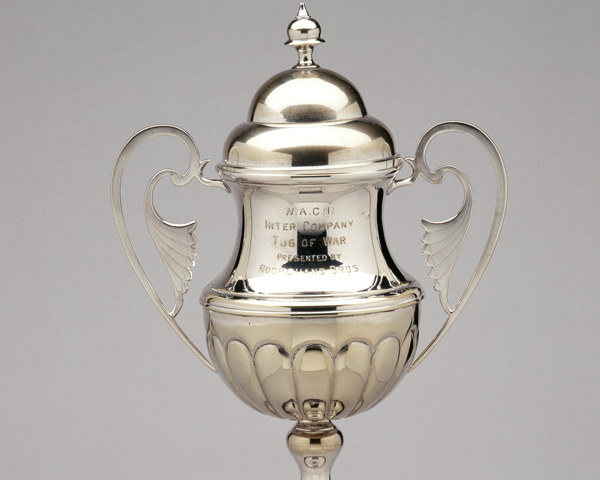
A soldier from 3rd Battalion The Parachute Regiment fights a boxer from Oxford University, 2009
A greater game?
The notion that war was a sporting contest writ large was commonly expressed during the late 19th and early 20th centuries when thousands of men enlisted to 'play the greater game'.
However, after experiencing the bitter realities of industrial warfare during the First World War (1914-18), this analogy between sport and war was replaced by an emphasis on the concrete advantages that sport could bring to the army.
School of manhood
These advantages included building physical fitness, boosting morale and encouraging unit cohesion. But sports like rugby, boxing and equestrianism have long been considered 'schools of true manhood and leadership'.
‘Fitness of body and contentment of mind come more readily in the free atmosphere of games. The platoon commander should organize in the afternoon football, cricket, boxing, and cross-country running, especially in competition with other platoons, and take part in them himself. The men will respond wholeheartedly, and will carry the spirit of their games into their work. A platoon which plays football, runs, and boxes, will be qualified to meet and overcome the stress and strain of battle.’Infantry Training Manual — 1932
Equestrian sports
British cavalrymen have always used equestrian sports to bolster their formal training. Tent-pegging, for example, improved both riding and combat skills. This sport took on a variety of forms, but usually involved a galloping horse and rider using a sword or lance to strike and pick up a target from the ground.
As with most other Army sports, it was used to encourage both comradeship and rivalry with other units, while preparing cavalrymen for war. Tent-pegging is still practised by the Household Cavalry Mounted Regiment of the modern-day British Army to demonstrate skilled horsemanship.
Racing
Throughout its history, the British Army has also organised race meetings. These have helped develop soldiers' horsemanship and allowed them to compete, as well as providing entertainment for the military and public.
Today, the annual Grand Military Race Meeting is open to servicemen and women. It has been held since 1841 and for over 130 years has taken place at Sandown Park racecourse.
Polo
British and Indian soldiers have long loved the game of polo, said to be the oldest team sport in the world. However, it was not until the middle of the 19th century that Captain John Watson of the 13th Hussars created the first set of written rules.
Polo was played by all British and Indian Army cavalry regiments as it helped develop soldierly qualities such as leadership, horsemanship, initiative, endurance, esprit de corps, teamwork and independence. Polo matches were also great social occasions, especially during the British Raj.
Today, military teams still participate in an inter-regimental tournament at the Guards Polo Club at Windsor.
‘The Army likes sports that are big on adrenaline. I didn't appreciate what it was like until I jumped over my first fence in a group of horses. It's terrifying and exciting at the same time. The nervous excitement I feel in the paddock is similar to the feeling I got on patrol in Afghanistan - you never know what's going to happen next.’Captain Max Chenery, King's Troop, Royal Horse Artillery — 2011
Tug-of-war
The British Army favoured the tug-of war as an ideal way of building up physical strength while simultaneously fostering co-operation and teamwork.
One of the finest Army teams during the 1950s was the Royal Army Ordnance Corps' (RAOC) detachment at Feltham in Middlesex. It won the 100 Stone title three years in a row from 1952 and the Catchweight title for four successive years between 1952 and 1955.
Boxing
Since ancient times, boxing has been considered excellent training for soldiers. The British Army has long believed it develops fitness, character, strength, persistence and courage. Today, the Army Boxing Association, working closely with the Amateur Boxing Association of England, makes sure the sport is regulated and its participants are safe.
Another form of boxing, known as 'milling', is used to train recruits in The Parachute Regiment. Participants wear gloves and head guards, as with regular amateur boxing, but they are not allowed to block or avoid incoming punches.
‘A soldier needs to be at the peak of his physical condition, and most of the Rangers will play some form of sport... Not only are we aggressive on the battlefield, but we channel our aggression into winning on the sports field. Controlled aggression on the sports pitches are excellent fitness training and also let out the warrior spirit in us all.’The Royal Irish Regiment — 2012














